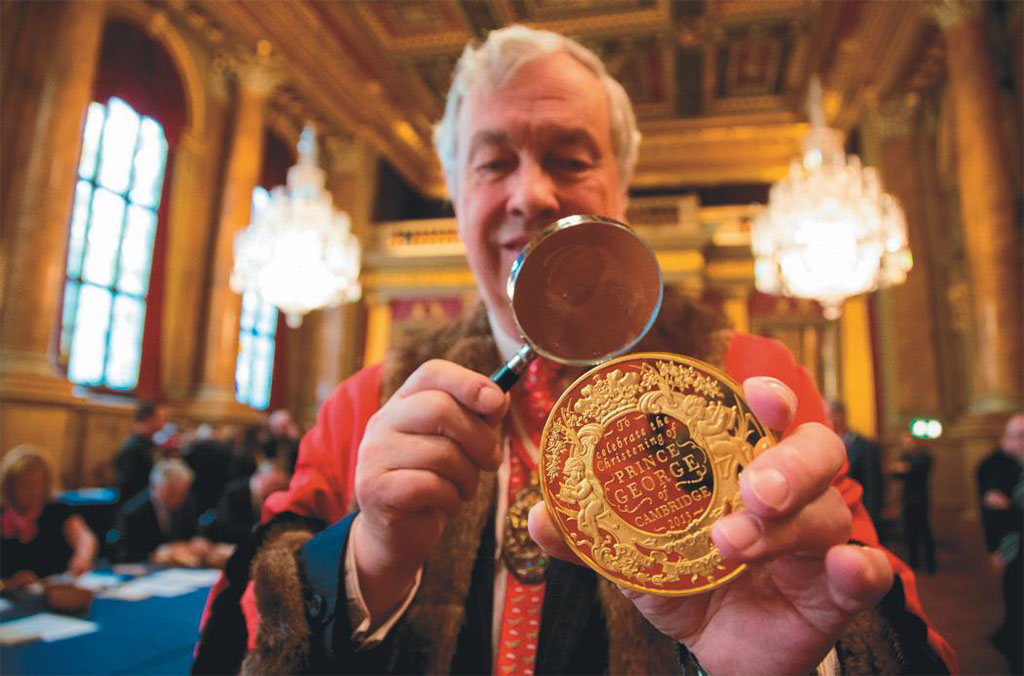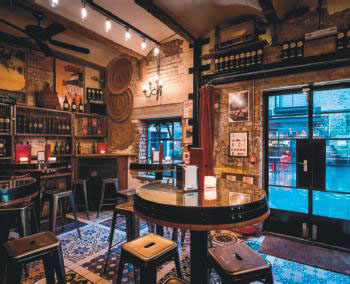
[caption id="ItsGoldGardensVikingsandTapas_img1" align="aligncenter" width="113"]

[caption id="ItsGoldGardensVikingsandTapas_img2" align="aligncenter" width="1024"]

SANDRA LAWRENCE
YOU CAN ALWAYS RELY on the City of London to supply a string of arcane rituals throughout the year. Many of them, like the Quit Rents Ceremony, have no real modern-day relevance whatsoever, but are lovingly continued for the sheer pageantry of it all. I was expecting anything with the name The Trial of the Pyx to be similarly bizarre, similarly colorful and similarly pointless. It takes place every spring at the sumptuous Goldsmiths’ Hall and tickets, though free, need to be reserved in the autumn through the Deputy Clerk’s office.
I had no idea what to expect, but I hoped it would involve robes and wigs. And yes! Our friend the Queen’s Remembrancer, Senior Master of Her Majesty’s Bench, who’d presided over the Quit Rents was there, complete with periwig, tricorn hat and long black gown. The difference was that this ceremony actually had a modern importance. Since the 12th century, the Worshipful Company of Goldsmiths have been in charge of checking the weight, quality and chemical composition of the monarch’s cash, and it’s deadly serious stuff.
Along the sides of the banqueting hall stood a small army of burly chaps in aprons, fresh from the Royal Mint and carrying large chests—the Pyx—containing around 50,000 newly minted coins of the realm, one sample from each batch forged. Around a giant table in the middle sat a jury of worthy London citizens with sets of scales, measuring implements and small wooden dishes.
The Assay Office then has two months to carry out the work before reporting back to the Queen’s Remembrancer, but frankly, after the pomp of the first hour it’s down to business and less interesting to members of the public so I carried on to see something I’ve been wanting to check out: A public park on top of an electricity sub-station behind Bond Street.
IT‘S HARD TO IMAGINE a time when Bond Street had a working-class area, but Victorian Brown Street and Hart Street were both poor neighborhoods. The Duke of Westminster built them a communal garden, but in 1902 a new-fangled electricity substation threatened to raze Brown Hart Gardens to the ground. The Duke objected and a compromise was reached; the glorious baroque-style Portland stone building, complete with pavilions, balustrading and Diocletian windows, was also given an Italianesque roof garden for the locals. In the ’80s the London Electricity Board quietly closed it, hoping no one would notice. At the back end of 2013, however, the garden was renovated and it’s now a delightful little oasis for weary Oxford Street shoppers. A stone’s throw from Selfridges, you’d never know it was there, but if you can find it there’s also a café by upmarket coffee chain Benugo.
I WAS HUGELY EXCITED to be invited to take a tour round the brand new Sam Wanamaker Jacobean playhouse just before it opened in January. The indoor theater was actually built at the same time as Shakespeare’s Globe and dear to Wanamaker’s overall vision, but had been a bit of a Cinderella in comparison to its flashy sister. It is a veritable jewel-box, entirely lit by candles, carved from oak, and fitted out in a transformation scene Cinders would be proud of.
[caption id="ItsGoldGardensVikingsandTapas_img3" align="aligncenter" width="313"]

ULI WEBER
[caption id="ItsGoldGardensVikingsandTapas_img4" align="aligncenter" width="350"]

THIS MONTH’s CONTACTS
The Trial of the Pyx
www.thegoldsmiths.co.uk
Brown hart Gardens
Just off Duke St., behind Bond St. Tube
Sam Wanamaker Theatre
www.shakespearesglobe.com
Vikings – Life and Legend
www.britishmuseum.org
Camino
www.camino.uk.com
The first production, The Duchess of Malfi, is just the kind of play the theater was built to present, and they’ve pulled out all the stops to make it memorable. Because of their close proximity with the audience, the actors had to find a new way to approach the text, and the result is startlingly intimate. One thing that really hit me was the brazenness of the Duchess’s (Gemma Arterton, fresh, direct and shameless) affair with her steward, and the very little effort she makes to conceal her pregnancy; something that hadn’t really occurred to me in previous productions. Perhaps because the action was so very close, I felt a lasciviousness in Webster’s classic I’d not really noticed before.
I was staggered, however, by the lighting. I could never have guessed how varied candlelight can be. The chandeliers were brought down almost to the stage for some very personal scenes and pulled to the ceiling for bigger, set-piece. One scene took place in pitch darkness, something I’ve not experienced. If I had one reservation about the production it was that, for a Jacobean tragedy, it felt curiously bloodless. Perhaps they didn’t want to get Kensington gore all over the brand new stage.
THE VIKINGS WERE NEVER short on blood, whether spilling it or, as the British Museum’s latest blockbuster Vikings: Life and Legend shows in graphic detail, being on the receiving end of an Anglo Saxon axe. The first exhibition held in the brand new Sainsbury Exhibitions Gallery, it’s a coup of the sort few museums can pull off. They’ve sourced objects from virtually everywhere the Vikings went, from the Middle East to North America, Russia to Spain, including stunning gold and silver jewelery, beautifully worked axes, swords, helmets (no horns, sadly, that’s a Victorian fantasy), shields, entire ship burials and, most impressive of all, a 37-metre-long warship, the largest discovered to date. It takes up the whole of the main room of the exhibition space and is a jaw-dropper of Viking craftsmanship and modern presentation.
I‘D BEEN MEANING to test out the tapas at Camino for a long while, but I don’t often get to Kings Cross, where it calls home. Happily, Camino came to me and there is now a branch in Blackfriars Lane, about a minute’s walk from St Paul’s Cathedral. The tapas upstairs was utterly superb—from succulent cocinillo (suckling pig belly) to juicy bacalao con romesco (roasted cod cheeks) and one of the best tortilla de patata I’ve had outside Spain. Even better, I’d been invited to one of the monthly cava tastings in the cellar downstairs and arranged to meet fellow British Heritage foodie James Graham, who I was relying on to tell me about all the different wines on offer. We must have tasted about 30 in total, many of which really buck the British-held myth that cava is just cheap and cheerful bubbly for people who can’t afford champagne. It has its own flavors and complexities; I’ll be looking on it with different eyes from now on. But for now, I’ll leave you with something James said to me that evening. It doesn’t matter what you’re drinking, be it a cheap bottle from a supermarket or the finest Manzanilla Cadiz can throw at you—it’s who you’re drinking it with. So until next time, whether you’re enjoying a quiet cerveza, limonada or cava, Salud!





Comments